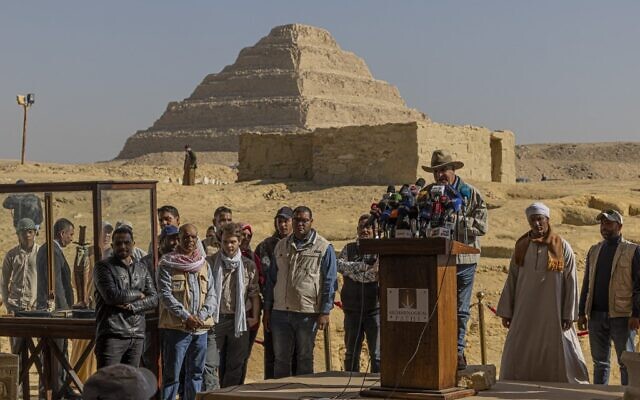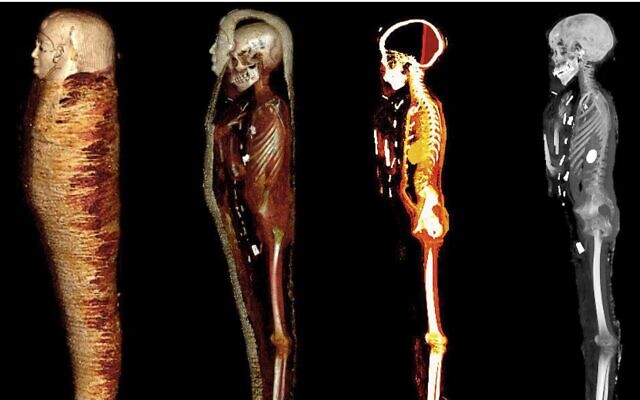SAQQARA, Egypt — Egypt unveiled Thursday a gold-laced mummy and four tombs, including of an ancient king’s “secret keeper,” discovered in the Saqqara necropolis south of Cairo.
The vast burial site at the ancient Egyptian capital Memphis, a UNESCO World Heritage site, is home to more than a dozen pyramids, animal graves, and old Coptic Christian monasteries.
Archaeologist Zahi Hawass, Egypt’s former antiquities minister, announced the latest discovery, dating from the fifth and sixth dynasties — around the 25th to the 22nd centuries BC — to reporters at the dig site.
The largest tomb, “decorated with scenes of daily life,” belonged to a priest, inspector, and supervisor of nobles named Khnumdjedef, said Hawass.
It was found in the pyramid complex of Unas, the last king of the fifth dynasty, who reigned some 4,300 years ago.
Another tomb belonged to Meri, who according to Hawass served as the pharaoh’s appointed “secret keeper,” a priestly title held by a senior palace official bestowing the power and authority to perform special religious rituals.

Archaeologist and Egypt’s former antiquities minister Zahi Hawass holds a press conference in the Saqqara necropolis, where a gold-laced mummy and four tombs including of an ancient king’s ‘secret keeper’ were discovered, south of Cairo on January 26, 2023. (Khaled DESOUKI / AFP)
A third tomb belonged to a priest in pharaoh Pepi I’s pyramid complex, and the fourth to a judge and writer named Fetek, Hawass added.
Fetek’s tomb included a collection of “the largest statues” ever found in the area, Mostafa Waziri, head of Egypt’s Supreme Council of Antiquities, told reporters.
Down a 15-meter shaft, the expedition also found a large limestone sarcophagus that had remained sealed “just as the ancient Egyptians left it 4,300 years ago,” Hawass said.
Inside was a mummy featuring “gold-leaf covering” that belonged to a man named Hekashepes, according to Hawass, who described it as one of the oldest and most complete non-royal mummies ever found in the country.
Other major findings from the excavation include statues, amulets, and a well-preserved sarcophagus.
In a separate announcement Tuesday, a group of scientists from Cairo University revealed previously unknown details about a mummified teenage boy dating to about 300 BCE. By using CT scans, the team of scientists were able to shed new light on the boy’s high social status by affirming the intricate details of the amulets inserted within his mummified body and the type of burial he received.

In this handout photo released on January 24, 2023, the layers of an Egyptian mummy dating to 330 BC are pictured using CT (computed tomography). ( Sahar N. Saleem via AP)
Egypt has unveiled many major archaeological discoveries in recent years.
Critics say the flurry of excavations has prioritized finds shown to grab media attention over hard academic research.
But the discoveries have been a key component of Egypt’s attempts to revive its vital tourism industry after years of political unrest, as well as after the COVID pandemic.
The government’s plans — the crowning jewel of which is the long-delayed inauguration of the Grand Egyptian Museum at the foot of the pyramids in Giza — aim to draw in 30 million tourists a year by 2028, up from 13 million before the pandemic.
The country of 104 million inhabitants is suffering from a severe economic crisis.
According to official figures, Egypt’s tourism industry accounts for 10 percent of GDP and some two million jobs.
